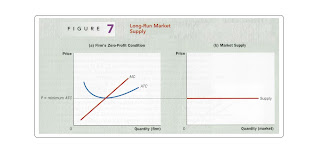Mostly summarized from Gregory Mankiw’s Principles of Economics, 5th Ed.
PART 5 Firm Behavior
and the Organization of Industry
Chapter
14 of 36
Firms
In Competitive Markets
Section
20 of 24
…
Figure
7 here
…
Per Figure
7 panel (a)
In the long run
firms enter or exit the market until economic profit is driven to zero.
If price (P) > average total costs (ATC) there
are profits, this encourages new firms to enter the market.
If P < ATC there are losses, this encourages
some existing firms to exit the market.
…
The process of firms entry into and exit from the
market ends when P settles at ATC.
Each
competitive firm maximizes profits (or minimizes losses) by choosing a quantity
at which P = marginal cost (MC)
Market
free entry and exit eventually forces P = ATC.
Therefore
at market equilibrium, P = MC = ATC and
there is no further market entry and exit.
MC =
ATC only when the firm is operating at minimum ATC.
…
Panel
(a) shows a firm’s long-run equilibrium lowest cost efficient scale.
P = MC, so the firm is profit-maximizing.
P =
ATC, so economic profits are zero.
New
firms have no incentive to enter the market and existing firms have no
incentive to leave the market.
In a competitive market, with free entry
and exit
· there
is only one P consistent with zero profit/loss
· it
is where P is at the minimum of ATC
…
Panel
(b) shows the long-run competitive market supply curve must be horizontal at the
given price.
Any
price above minimum ATC
·
would generate economic profits
·
leading to entry of new firms
This
would result in an increase in the total quantity supplied and profit driven
back down to zero.
…
Any
price below minimum ATC
·
would generate economic losses
·
leading to exit of existing firms
This
would result in a decrease in the total quantity supplied and losses driven
back up to zero.
Eventually,
the number of firms in a competitive market
· adjusts
so P equals the minimum of ATC
· resulting
in enough firms and supply to satisfy all the demand at this price
… …



Comments
Post a Comment